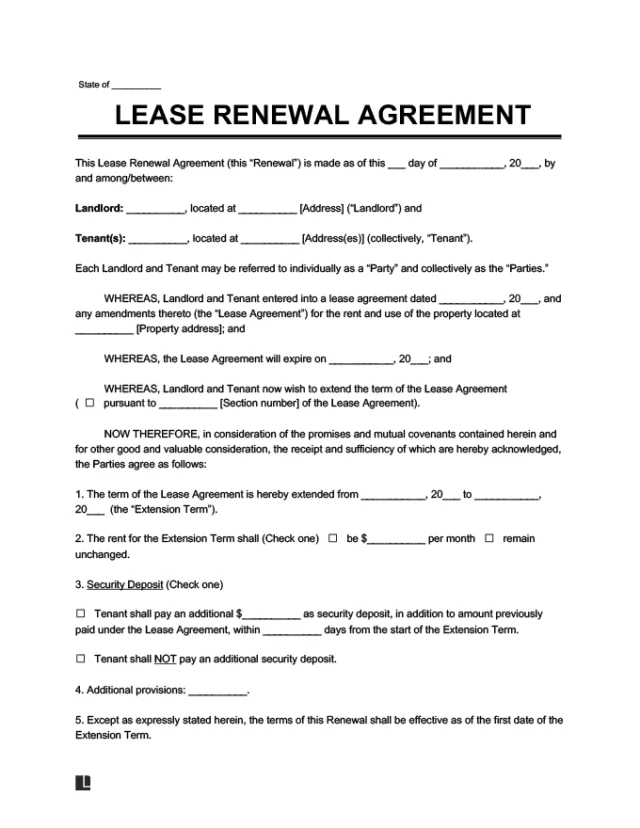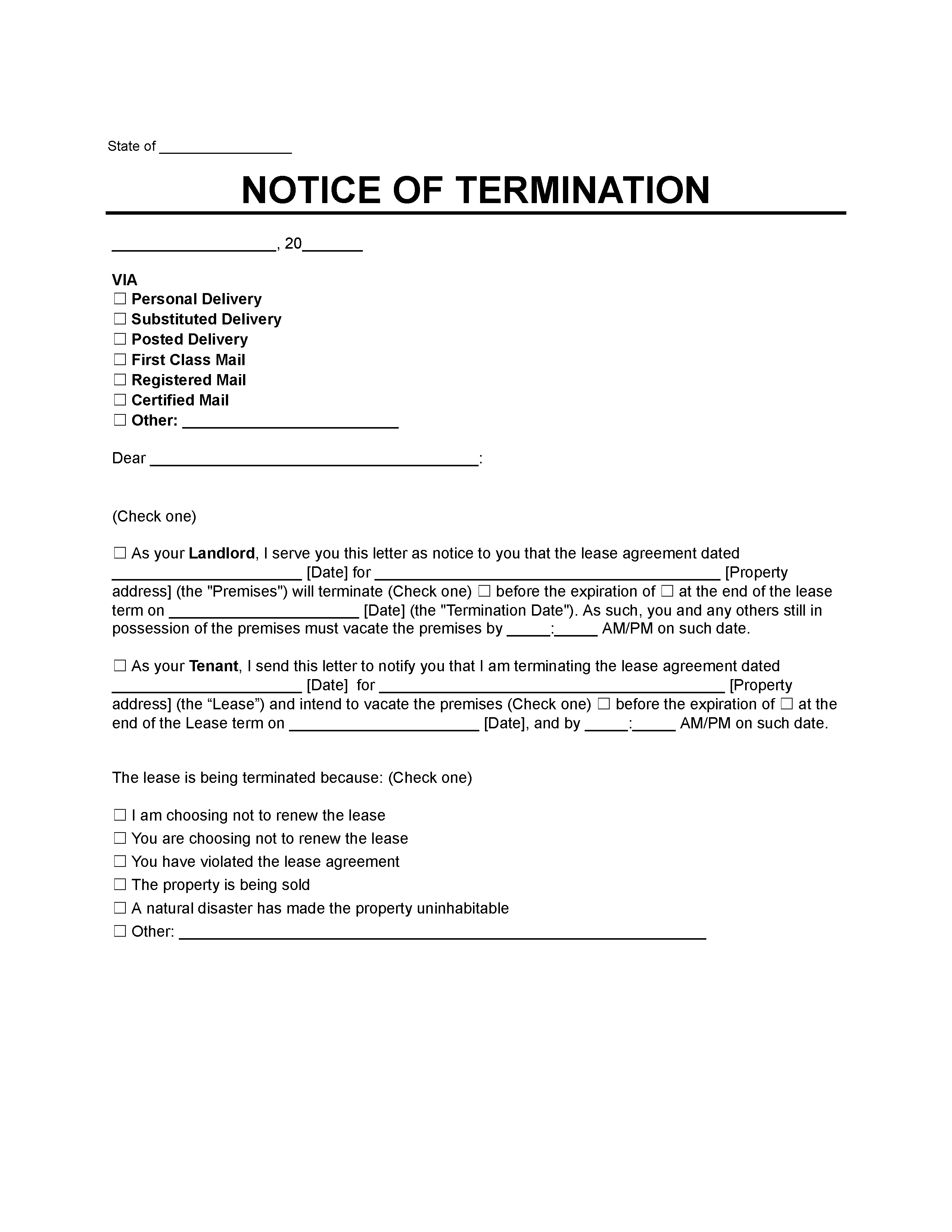Lease Termination Letters – By State
Depending on where you’re ending your lease, you will want to use a state-specific form to ensure you comply with applicable legal requirements. Legal Templates offers lease termination letter templates for each state, so you can choose the one that aligns with your area’s laws.
- Alabama
- Alaska
- Arizona
- Arkansas
- California
- Colorado
- Connecticut
- Delaware
- District of Columbia
- Florida
- Georgia
- Hawaii
- Idaho
- Illinois
- Indiana
- Iowa
- Kansas
- Kentucky
- Louisiana
- Maine
- Maryland
- Massachusetts
- Michigan
- Minnesota
- Mississippi
- Missouri
- Montana
- Nebraska
- Nevada
- New Hampshire
- New Jersey
- New Mexico
- New York
- North Carolina
- North Dakota
- Ohio
- Oklahoma
- Oregon
- Pennsylvania
- Rhode Island
- South Carolina
- South Dakota
- Tennessee
- Texas
- Utah
- Vermont
- Virginia
- Washington
- West Virginia
- Wisconsin
- Wyoming
What Is a Lease Termination Letter?
A lease termination letter is a formal document stating the landlord’s or the tenant’s intention to end a lease. It extends a courtesy and helps the sender fulfill legal obligations. They use it to give a certain amount of state-required notice, clarifying when the property will be vacant.
A lease termination letter is often for month-to-month leases. You can also send this letter to end another periodic lease, like a year-to-year or week-to-week lease. If a disagreement arises with your attempt to end a lease, a court may not side with you if you didn’t use a lease exit letter to provide the standard notice. Our lease termination letter protects you in case of legal disputes.
Note that an eviction notice differs from a lease termination letter. An eviction notice only comes from a landlord, informing a tenant that they must fix a lease violation or move out. A landlord or tenant sends a lease termination letter due to changes in circumstances. Meanwhile, a landlord sends an eviction notice letter due to a tenant’s non-compliance.
| Factor | Lease Termination Letter | Eviction Notice |
|---|---|---|
| Initiating Party | Landlord or tenant | Landlord |
| Voluntariness | Voluntary choice to initiate but the other party must respect it | Tenant must fix the issue or move out |
| Reasons | Mutual agreement or change in circumstances | Late rent payments, noise complaints, other violations |
| Outcome | Tenant leaves on their own | Tenant leaves on their own or landlord proceeds with eviction process |
What If I Need to End a Lease Early?
Whether due to personal or legally protected reasons, you may need to end your lease early as a tenant. If this is the case, you can use Legal Templates’s early lease termination letter. Depending on the reason, you may incur penalties, forfeit your security deposit, or be required to pay rent until the landlord finds a new tenant.
Ending a Fixed-Term Lease
If everything goes according to plan with a fixed-term lease, but you don’t want to renew it, you can prepare a non-renewal letter to send to the other party.
State Rules for Terminating a Lease
The requirements for a lease termination letter vary by state. Many states require 30 days’ notice (a 30-day notice to vacate), but some need more or less notice. The amount of required notice depends on where you live and whether you’re the landlord or the tenant.
When you use a letter that accounts for your state’s notice requirements, you can ensure that you are in compliance with state laws regarding notice of lease termination. To understand your obligations, review state laws regarding the notice a landlord or tenant must give before terminating a month-to-month lease.
| State | Tenants' Required Notice | Landlords' Required Notice | Laws |
|---|---|---|---|
| Alabama | 30 days | 30 days | AL Code § 35-9A-441 |
| Alaska | 30 days | 30 days | AK Stat. § 34.03.290 |
| Arizona | 30 days | 30 days | AZ Rev. Stat. § 33-1375 |
| Arkansas | 30 days | 30 days | AR Code § 18-17-704 |
| California | 30 days | 30 days | CA Civ. Code § 1946 |
How to Write a Lease Termination Letter
A lease termination letter helps you comply with local landlord-tenant laws and communicate your intentions. The writing process is similar for landlords and tenants, given that they follow their distinct requirements. Learn the steps involved below.
Step 1 – Review Your Lease & Local Laws
Study state laws before writing a lease termination letter, as they dictate the amount of notice you must give. Understand the differences between landlord and tenant obligations, as your required notice period may differ depending on who you are.
You must also consult the original lease to ensure compliance with termination clauses. If the lease requires more notice than state law, the lease’s provisions will typically apply, as state law only provides a minimum necessary notice period. However, if the lease requires less notice than state law, state law will override the lease.
If you don’t give enough notice of termination of the lease, you may not be able to terminate your lease early. Understand your obligations beforehand to avoid any confusion.
Step 2 – Clarify Which Party You Are
Identify your role in the agreement as the tenant or the landlord. Our guided form makes this step easy, allowing you to identify yourself at the beginning of the process. The wording will be updated in your final letter to reflect the parties’ identities. You must also list information about the other party, the tenant or the landlord, to address them properly.
Step 3 – Provide Termination Details
Include a deadline (date and time) for ending the lease. The timeline you give must comply with your state’s laws and the terms of your lease.
You can also include a lawful reason for the termination. State laws give guidance on what constitutes a legal versus an illegal reason. For example, a landlord’s lease termination letter might specify changing how they plan to use the property (legal) as a reason, but not the tenant’s cultural identity (illegal).
If you don’t provide a lawful reason, the other party can challenge the termination. In this case, you must keep fulfilling your obligations under the lease until the dispute is resolved.
Step 4 – Reference the Original Lease
The letter should list the property address and the date of the original lease and reference the section that includes the early termination clause. By offering this information, you bring clarity and certainty to the letter. There will be no doubt that you and the other party know which lease you are ending.
Step 5 – Finalize Details
A termination of lease letter should have a forwarding address. This tells the landlord where to send the security deposit or otherwise communicate with the tenant.
You can also indicate whether you want proof of service, which is an acknowledgment that someone has delivered the termination letter. Proof of service can be helpful, especially in refuting claims of improper or insufficient notice.
Lease Termination Letter Samples
View our sample lease termination letters to learn what they look like and understand which one you need. Then, create your own using our guided form. Available to download in PDF or Word format.
Sample Lease Termination Letter to Landlord
View an example of a tenant’s lease termination letter template (from a tenant to a landlord).
Sample Lease Termination Letter to Tenant
View an example of a landlord’s lease termination letter template (from a landlord to a tenant).
Landlords’ Obligations When Ending a Lease
As a landlord, you have certain obligations when you end a lease. You’ll have to return the tenant’s security deposit as outlined in your state’s laws and the lease, usually within 14 to 30 days. Landlords may keep part of the deposit for damage repair or cleaning costs if applicable.
You must also follow a rental inspection checklist to assess the property’s condition. This can help determine whether you need to keep part of the deposit or do any renovations before a new tenant comes in.
Use a Security Deposit Return Letter
Send a security deposit return letter to the tenant to communicate any deductions.
Tenants’ Obligations When Ending a Lease
As a tenant, you have rights and obligations when ending a lease. You should make any necessary minor repairs and leave the unit in good condition. Follow the landlord’s instructions for moving out, such as where to deliver the keys.
If the landlord fails to return your security deposit, and you’re rightfully owed it back, talk to them about getting a partial or full refund. If speaking with your landlord doesn’t work, you can write and send a security deposit demand letter.










